‘Your worst nightmare’: Inside the deadliest night of Israel’s attacks on Gaza
More than 40 people died when Israeli airstrikes targeted Wehda Street in Gaza on 16 May. Middle East Correspondent Bel Trew investigates what happened on that night of bloodshed

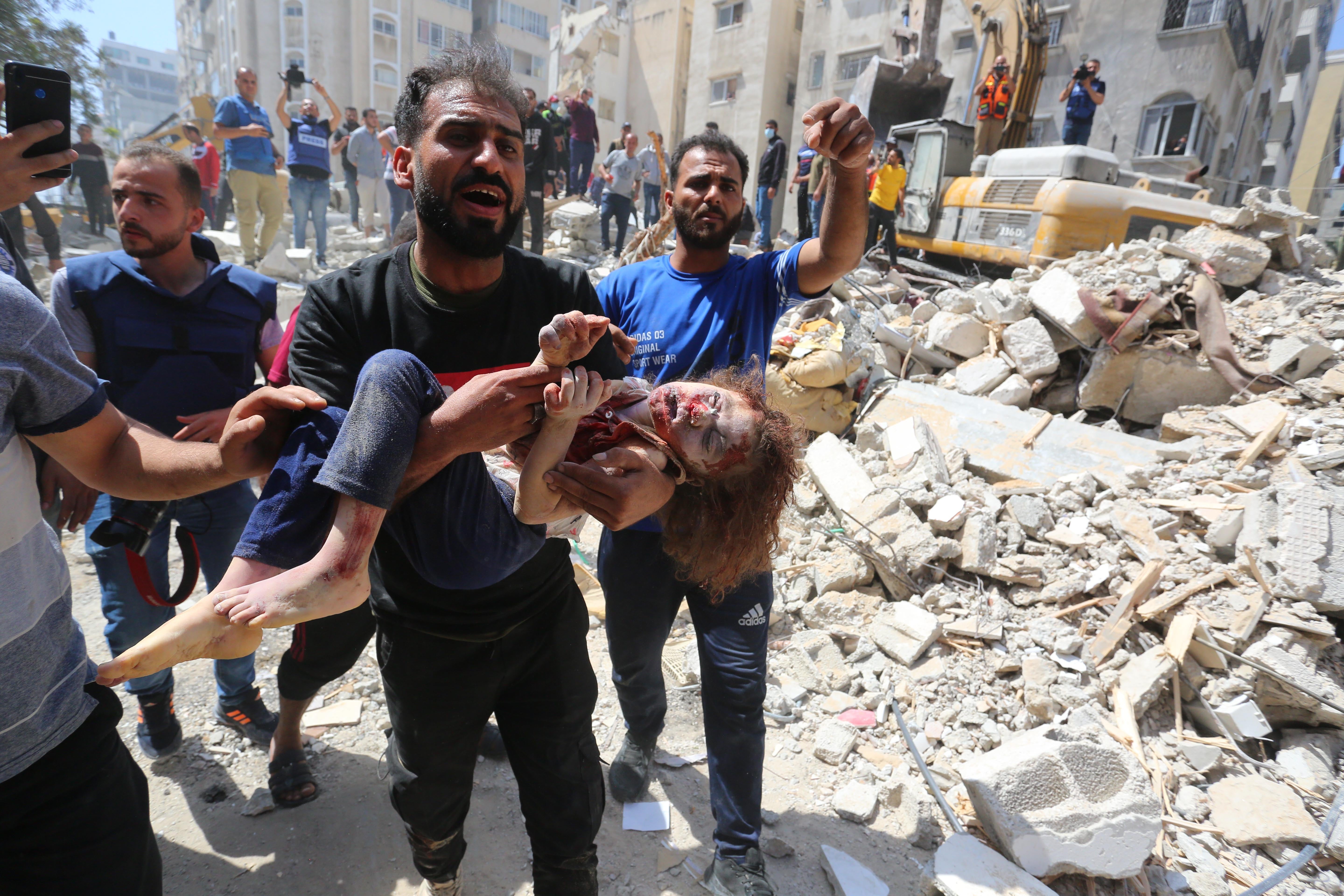
Your support helps us to tell the story
From reproductive rights to climate change to Big Tech, The Independent is on the ground when the story is developing. Whether it's investigating the financials of Elon Musk's pro-Trump PAC or producing our latest documentary, 'The A Word', which shines a light on the American women fighting for reproductive rights, we know how important it is to parse out the facts from the messaging.
At such a critical moment in US history, we need reporters on the ground. Your donation allows us to keep sending journalists to speak to both sides of the story.
The Independent is trusted by Americans across the entire political spectrum. And unlike many other quality news outlets, we choose not to lock Americans out of our reporting and analysis with paywalls. We believe quality journalism should be available to everyone, paid for by those who can afford it.
Your support makes all the difference.At just a few minutes before 1am, Mohammed al-Kollaq, 24, was awake and messing about on his mobile phone when Israeli warplanes unleashed what would be the deadliest air raid of the recent 11-day conflict.
In that freeze-frame moment before the bombings, which killed at least 21 members of the extended Kollaq family, Mohammed’s uncle, Shoukri, was making sure his children were asleep.
Just a few metres down Wehda Street in another apartment block, Riad Ishkunta, 42, was catching up on the latest news while his wife was checking on their children, who had been moved away from the windows as a precaution.
One floor down in the same building, 17-year-old Omar Abu al-Auf was watching television with his father Ayman, 49, a celebrated doctor who had been heading up Gaza’s coronavirus response.
For those few precious seconds, Wehda, a main thoroughfare in Gaza City, was quiet. No one knew what was about to happen.
“This was the safest place we knew of,” Mohammed said, several days after the bombardment, standing on the rubble of the two buildings which had housed his family.
“But out of nowhere, we heard the bombing. It sounded and felt like an earthquake. The ground disappeared beneath my feet.”
At least 45 civilians, including 18 children, were killed in dozens of airstrikes on the Rimal neighbourhood that night, according to The Independent’s own investigation. For Palestinian civilians, it was the deadliest night of bombing during the recent conflict between militants in Gaza and the Israeli military.
The attack has raised questions over whether Israel violated international norms by launching an air raid, without warning, on an overwhelmingly civilian enclave, inflicting “gratuitous” death and destroying the lives of non-combatants.
“Heavily bombing a street without warning with houses full of civilians is likely to be disproportionate, which is a war crime,” Saleh Hijazi, deputy regional director of Amnesty, told The Independent.
“Even if the collapsed houses and civilian deaths and injuries were indirectly caused by ‘bombing a military objective’, these are circumstances the Israeli army should have been able to foresee and account for,” he added.
The Israeli army vehemently rejects this view, claiming that its warplanes were targeting Hamas’s military infrastructure that night, including a network of underground attack tunnels – nicknamed the “metro” – which it says is partially located beneath streets in the district of Rimal, including Wehda Street, where so many homes were destroyed.
A senior Israeli military official admitted to The Independent that the civilian death toll was far higher than had been expected. He said that the air force had hit the road at an angle, aiming to destroy the underground structures, but in their calculations did not anticipate that the apartment blocks, where Mohammed, Shoukri, Riad and Omar lived, would collapse.
Heavily bombing a street without warning with houses full of civilians is likely to be disproportionate, which is a war crime
The same official said that the Israeli air force believes there may have been explosives or munitions stored in the cavities they were hitting, which ultimately caused the collapse, but did not provide evidence backing up this claim, saying investigations were still ongoing.
He shared a map of the 11 strike sites on Wehda Street, which he said were located in the centre of the road to minimise collateral damage.
“We used a standard type of ammunition that we have used hundreds of times elsewhere in Gaza, which has proven to be very effective and very accurate,” the official told The Independent, adding that the explosions all occurred “deep underground”.
“All the bombs were timed in such a way as to penetrate the ground and then explode only underground after a few metres, so that the force of the bomb would be directed down and there would be minimal collateral damage to anything above the surface,” he said.
“A lot of damage was done to Hamas’s underground infrastructure, which was the intended target of the strike. Our assessment is that [the strikes] hit where we intended,” the official added.
“It was a massacre”
The snarl of violence that erupted last month and raged between Israel and Gaza was even more intense than the seven-week war in 2014, according to UN officials.
Over the course of 11 days, Hamas militants in Gaza fired more than 4,000 rockets – an unprecedented number – at Israel, leaving 13 dead including two children and a soldier.
In Gaza, the Israeli military struck hundreds of targets, leaving nearly 250 dead, including over 60 children. There is a dispute between the Israelis and the Palestinians over how many of those killed in Gaza were combatants, with the Israelis claiming to have killed hundreds of militants.
But 16 May was the deadliest night for Palestinian civilians, and rights groups have raised concerns about proportionality.
Interviews with survivors, family members, neighbours, officials and witnesses show that there were dozens of strikes in the neighbourhood, causing the collapse of three residential apartment blocks: the Abu al-Auf building, which has two wings, and another two apartment blocks, which housed the extended family of Mohammed al-Kollaq.
According to The Independent’s calculations from documenting the strike sites on the ground, the planes hit at least 11 points along Wehda Street, damaging water pipes as well as chewing up one of the main access points to Gaza’s largest hospital, al-Shifa.
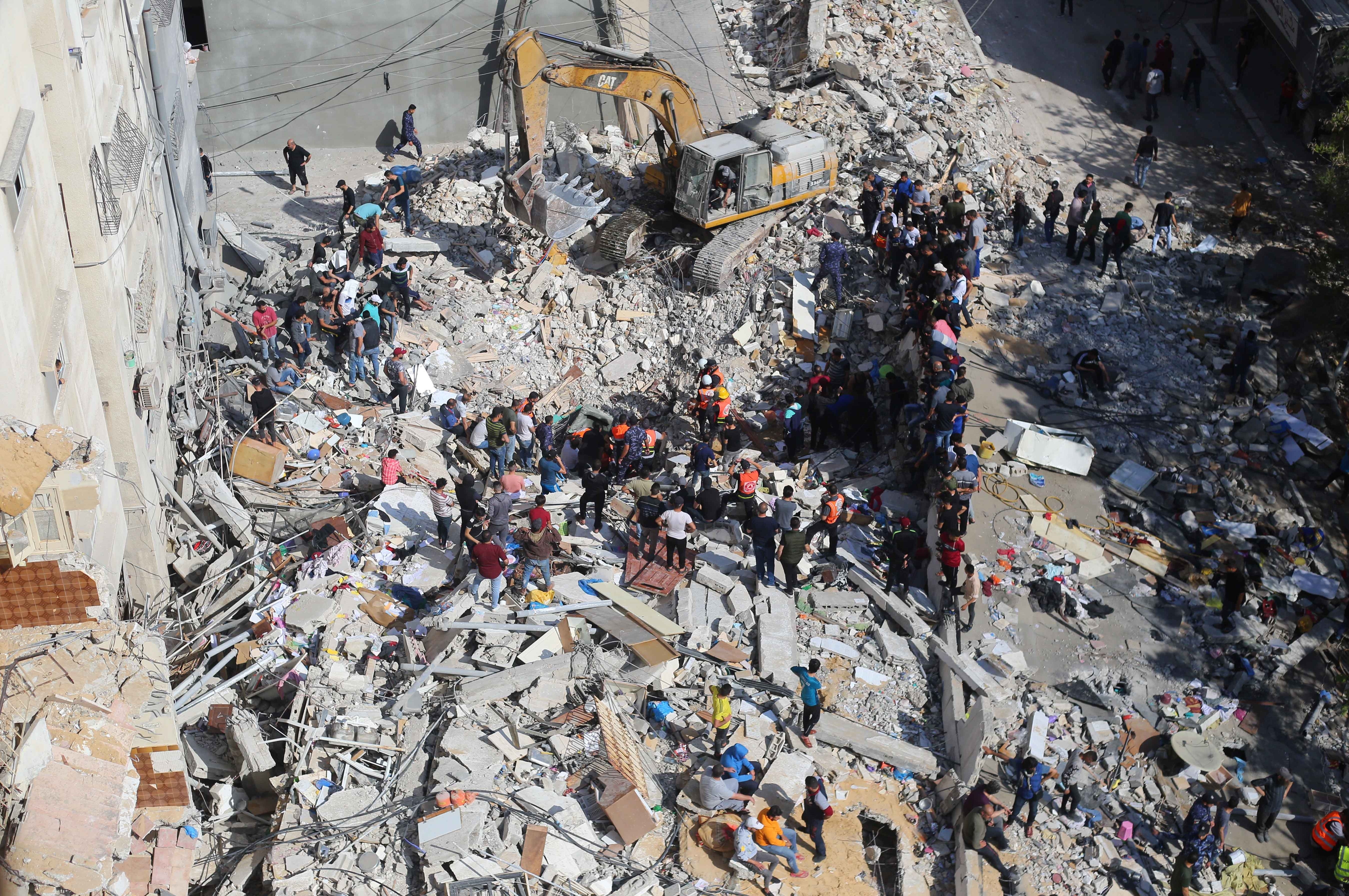
The bombardment continued that same evening along a parallel street to Wehda, called Thawra, where two Palestinian ministry buildings were partially or completely destroyed as well as part of a clinic run by the relief organisation Médecins Sans Frontières.
Three streets east, near Palestine Square, a strike on the same night killed one of Gaza’s only neurologists, Dr Moeen al-Loul, and a man named Loay Aouda, in two flats which were located on the first floor of the building above a clothing store.
Israelis said that neither of the doctors killed that night – Dr Abu al-Auf and Dr al-Loul – were targets, and that Dr Al-Loul’s flat was struck because it was “an operational apartment” used by Hamas. They did not elaborate further. Witnesses who live in Dr Al-Loul’s building told The Independent they received no warning prior to the bombardment.
Rights groups investigating that night’s bombings say that the army may have violated international law, given that the strikes hit such a heavily populated neighbourhood, causing such a high death toll, and that there was no apparent warning.
Experts said that fragments found near the Kollaq house were likely to have come from GBU-31 bombs – powerful munitions packed with 430kg of high explosives – which are typically used for large buildings, but can be used to destroy underground targets.
Shrapnel found by The Independent in the same area appeared consistent with this type of munition, but the pieces were not substantial enough to determine anything conclusive.
“The intrinsic wide-area effects of large explosive munitions mean they must be used judiciously in the urban environment,” NR Jenzen-Jones, the director of Armament Research Services, a specialist arms investigations firm, told reporters.
The Israeli military declined to comment when asked by The Independent about the use of specific munitions.
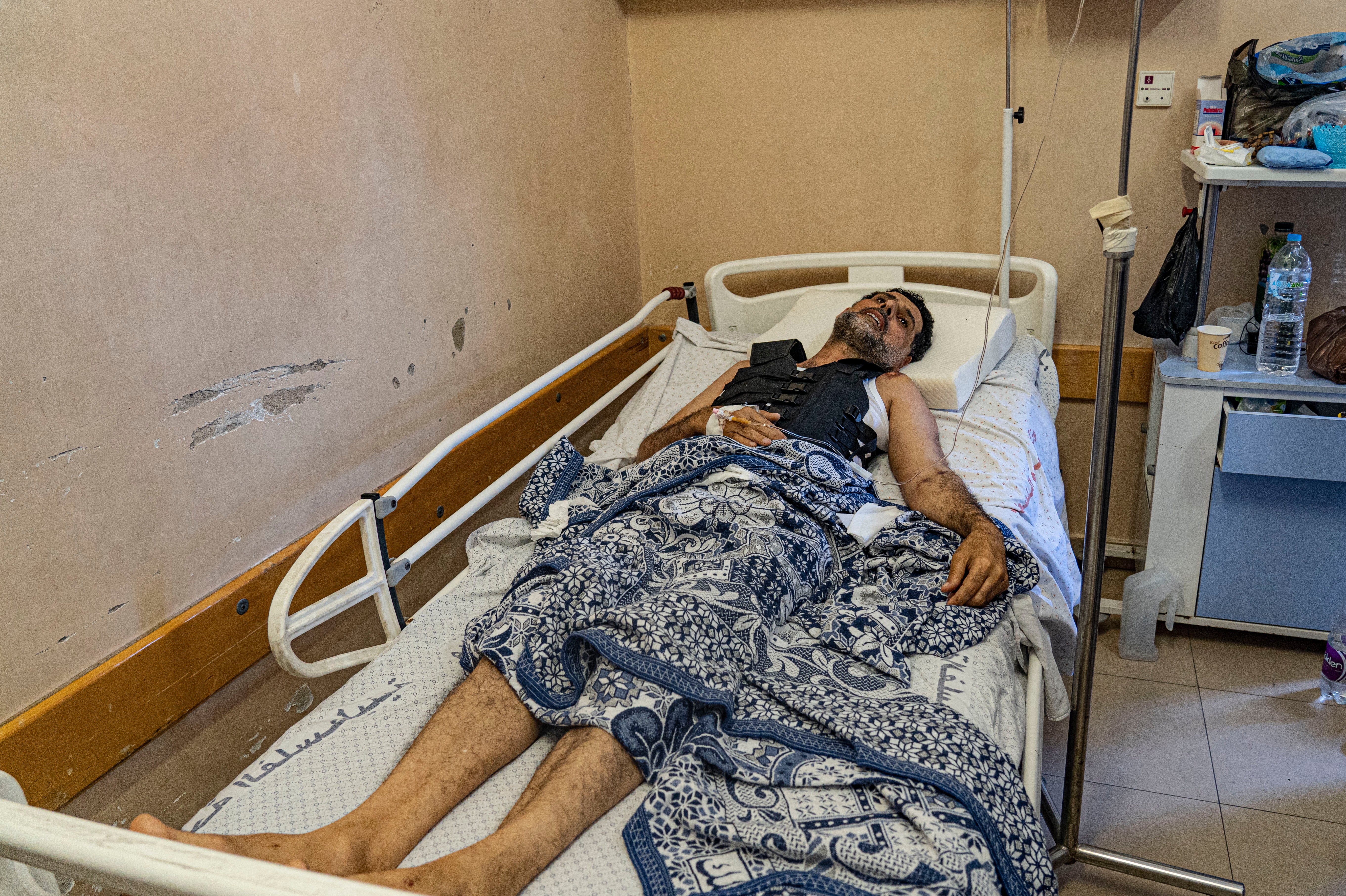
But pressure is mounting. Michelle Bachelet, the UN high commissioner for human rights, has already voiced concern that the deadly Israeli strikes on Gaza, as well as Hamas’s unprecedented and indiscriminate rocket barrage on Israel, might constitute war crimes.
The UN’s human rights office (OHCHR) told The Independent that investigations were underway, and that the UN’s Human Rights Council had voted to launch an international probe into alleged crimes committed by all sides, a decision Israeli prime minister Benjamin Netanyahu rejected and called “shameful”.
Israeli and Palestinian militant groups are already being investigated by the International Criminal Court over alleged war crimes committed by all sides in the occupied Palestinian territory (another investigation that is rejected by Israel).
“It does look severely disproportionate,” said Hijazi, the regional deputy director for Amnesty. “But we would need to know more about the tunnels and the types of weapons they used in the attack, which we are not able to do,” he added, saying that rights groups do not have permission to enter Gaza.
The senior Israeli military official told The Independent that warnings were not issued on the night of 16 May because “we didn’t assess that there would be that type of damage”.
But Mohammed said it meant his family had no way of being able to hide. He said the third strike, which he believes struck behind the house and felt like a direct hit, caused the total collapse of the building.
We have done the most we could in order to minimise collateral damage
He said he grabbed his mother, Sana, whose legs were pinned under the rubble. He frantically called friends in order to pinpoint his location, but together they were trapped for nearly 12 hours in a concrete tomb that was just 60cm high.
His uncle, Shoukri, 51, who was one floor above, lost three of his children and his wife that night but miraculously survived. He was also trapped under the rubble.
“The sound kept ramming inside my head, everything was shaking so hard,” he said from his hospital bed, where he is being treated for multiple injuries, including a broken back.
“It was a matter of seconds. It was a scene from your worst nightmare – smoke, gas, fire, screaming. It was a massacre.”
“The safest place in Gaza”
Wehda Street, one of the best-known streets in the 40-km long strip, is now a forlorn reef of funeral wakes, lined with posters displaying the names of the dead. Before the bombing it rolled northwest across Gaza City, past the Ministry of Health’s administrative buildings, a cluster of bakeries, apartment blocks and clothing stores, towards the strip’s largest hospital, al-Shifa, and eventually to the sea.
It is part of one of Gaza’s most populated neighbourhoods, known as Rimal, which, during the last three wars, provided a safe haven for civilians caught in the crossfire in areas closer to Israel.
In fact, just a few days before the bombing, Mohammed’s older brother Sameh, 28, fled to Wehda from the northern part of the strip, believing it was safer for his family. It was a calculation that would prove fatal: he, his wife and his two children – the youngest aged just 6 months old – were all killed.
Another family, the Sukkars, were camping that night in a building site. They believed that staying in an area providing partial shelter on Wehda Street was still safer than staying at home in their neighbourhood.
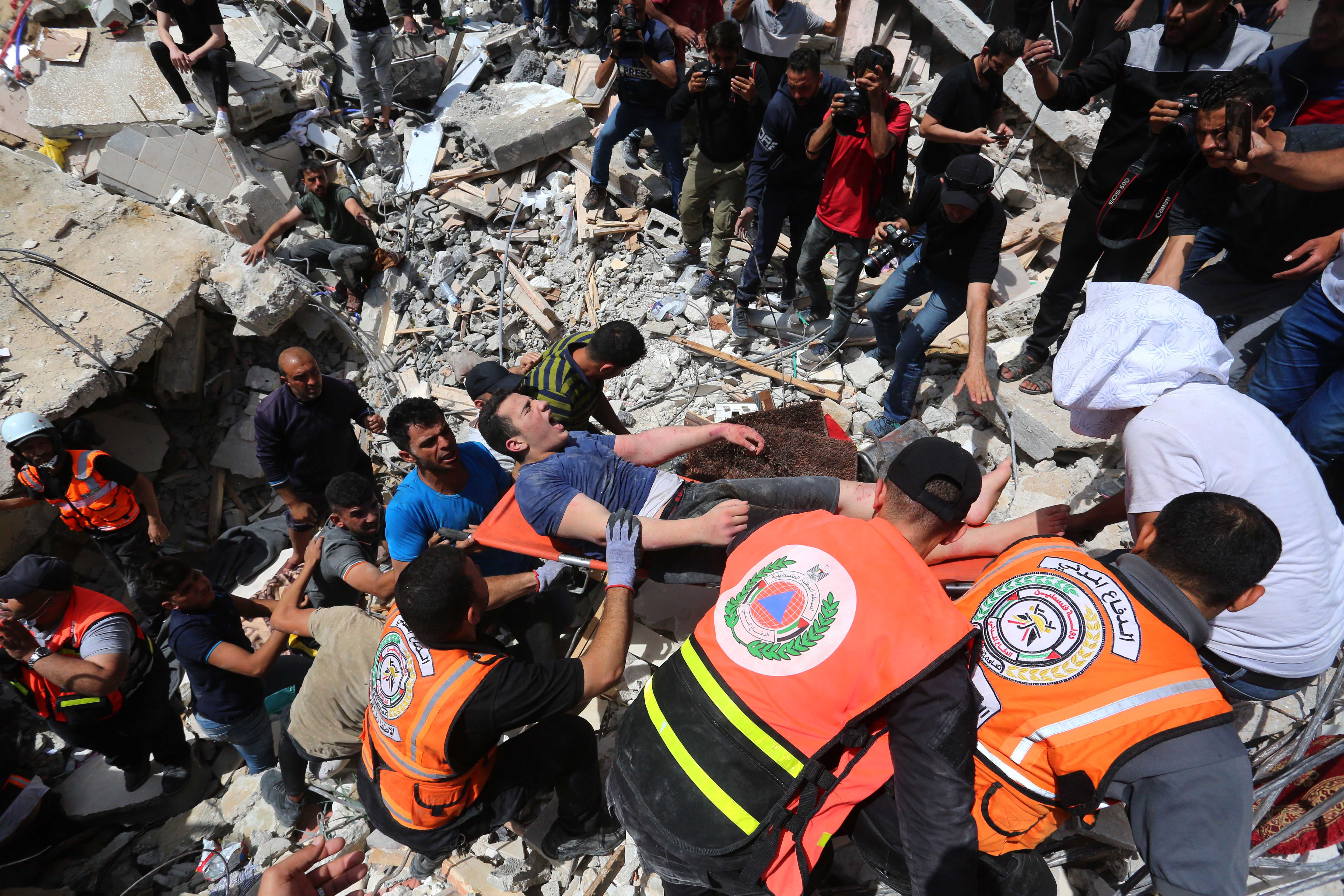
They only just survived, and the father, Harb Sukkar, was among those who helped pull Riad’s only surviving daughter, Susie, 7, out from under the rubble to safety.
“I was just 200 metres away from the Abu al-Auf building, and couldn’t believe my eyes when so many missiles struck,” Sukkar told The Independent from a United Nations school where he is now living with his four children after his own home, in the north of Gaza, was destroyed. “We heard the girl crying. It took us over five hours to get her out,” he said of Susie, showing photos of the rescue.
Today the street resembles a pockmarked moonscape, with large and small craters, some of which have been filled with sand.
One of the craters, just a few metres northwest of the Kollaq building, yawns open to reveal a destroyed storm drain that is pouring wastewater into the ground, polluting the area and destabilising a neighbouring multi-storey block. The building, which is leaning precariously to one side, is – according to the owner – home to 15 flats and seven shops, and is now scheduled to be pulled down.
The Israelis claim that Rimal neighbourhood was “rife” with military infrastructure that Hamas intentionally co-located with civilian buildings, including command-and-control facilities above ground that they highlighted in aerial photographs.
“We have really done the most we could in order to minimise collateral damage,” a senior Israeli official told The Independent, adding that the ratio of militant to civilian deaths – which they calculate as one to one – was “phenomenal, as cynical as it sounds”.
“That is small solace for anyone affected here. That is not our aim. We have not tried to strike any civilians, or the houses or anything else,” he added.
“The delay cost lives”
The last thing Riad Ishkunta, 42, remembers is watching his wife scream as she frantically tried to pull their five children out from under the roof, which had partially collapsed on them.
He was on the third floor of the Abu al-Auf building, in a rented flat, when the first bomb ripped off the front of the building, partially trapping his children.
He was trying to reach his wife to help when another bomb dropped, the floor beneath his feet fell away, and the building collapsed, taking his entire family with it.
Riad and his seven-year-old daughter, Susie, are the sole survivors.
Skewered by an iron bar, he lay trapped under the rubble for six hours, separated from his loved ones by collapsed walls.
I was under the rubble for six hours, my only surviving child for 10. Why did they do this?
“They found my daughter Susie upside down and alive, her head stuck between two bricks, which protected her,” he told The Independent from a funeral wake beside the ruins of his home a few weeks ago.
“I was under the rubble for six hours, my only surviving child for 10. Why did they do this?”
Gaza’s municipality workers who manned the emergency response said the additional bombing made it hard to reach those under the rubble, and the massive craters in the road prevented them from bringing in diggers, or even ambulances, quickly.
The bombing of the street restarted the next day, also complicating rescue efforts, municipality officials claimed.
On the afternoon of 17 May, Israeli warplanes took out the top floors of a building further down Wehda Street. The shrapnel and debris from that strike killed Ziad Abu Dayr, 54, and his niece Rafif, 10, according to witnesses, neighbours and health officials.
It also destroyed Gaza’s only PCR testing laboratory and damaged Health Ministry building across the road. The Independent has reached out to the Israeli military about the target of that strike but has yet to recieve a reply.
The few remaining members of the Abu al-Auf family claim that delays in the rescue effort cost lives.
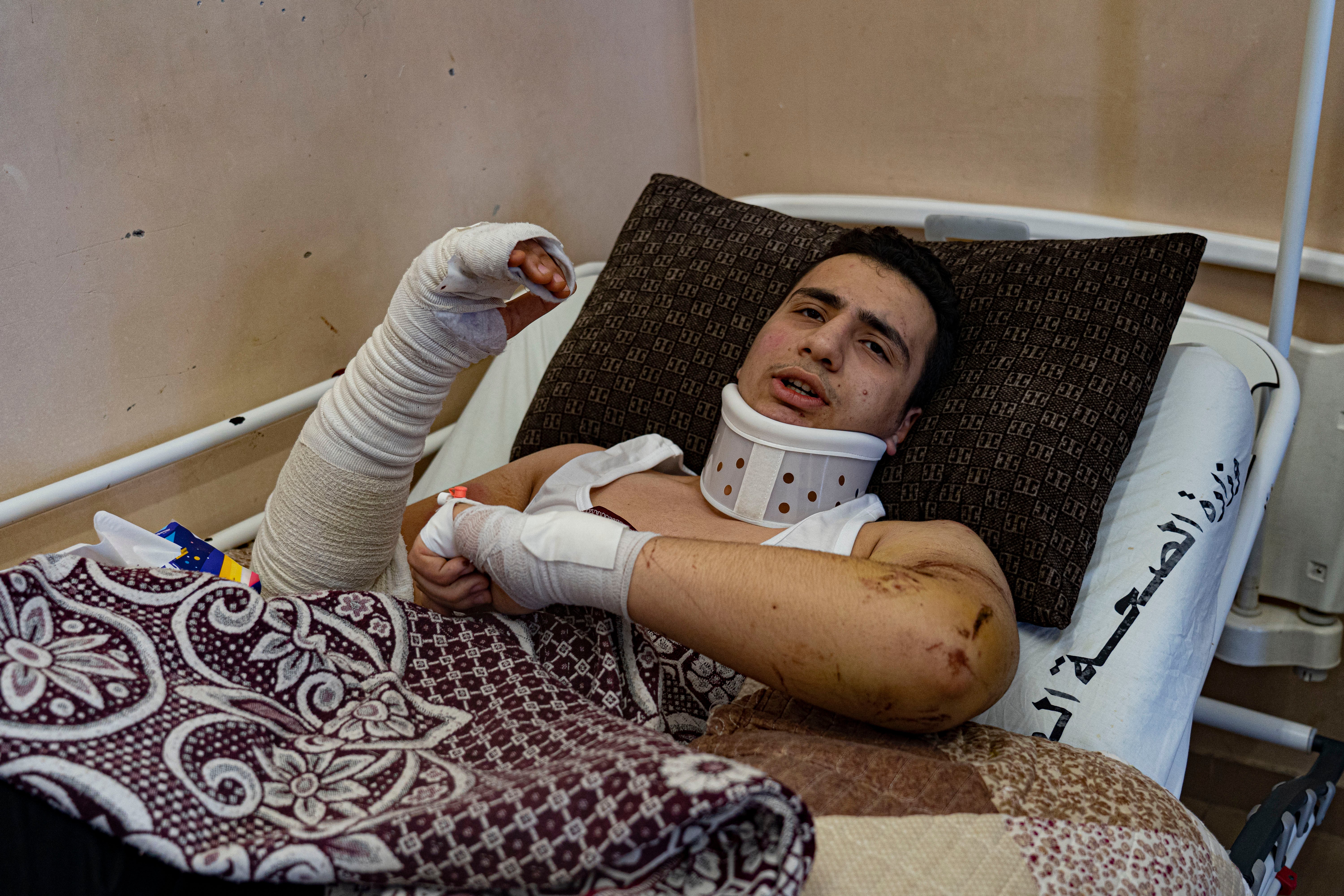
“I am all alone in the world”
Omar Abu al-Auf, 17, is the sole survivor from his close family, and said his 13-year-old sister, Tala, who was initially alive after the bombardment, died in his arms while they lay trapped for 10 hours under the rubble.
He lost a dozen relatives, including both his parents, all his siblings, two grandparents, and most recently Diana, the wife of his father’s cousin Alaa, who was in a critical condition in a hospital in the West Bank until she reportedly died a few days ago.
In his building, five members of the Ifranji family (who were related to the Abu al-Aufs) were also killed on the second floor, as well as a man named Hazem Qumo who lived on the fourth floor.
Omar, like Riad, counted around four bombs before he lost consciousness.
“I don’t know what to say, we were all civilians. I lost my entire family, and I am all alone in the world,” he said from his hospital bed, where he is starting the long road to recovery.
“I am just desperate to find out why they did this.”